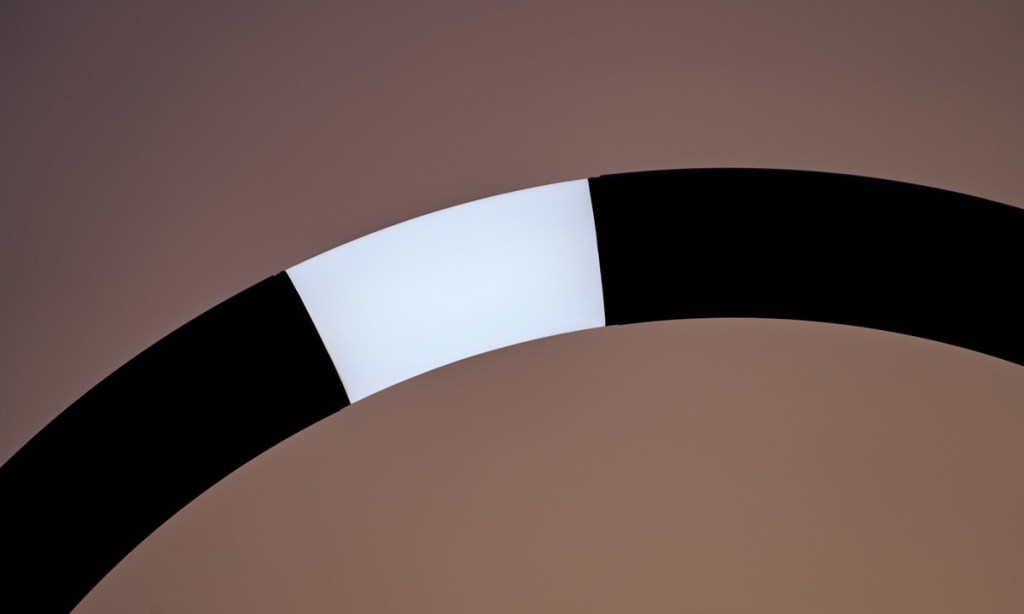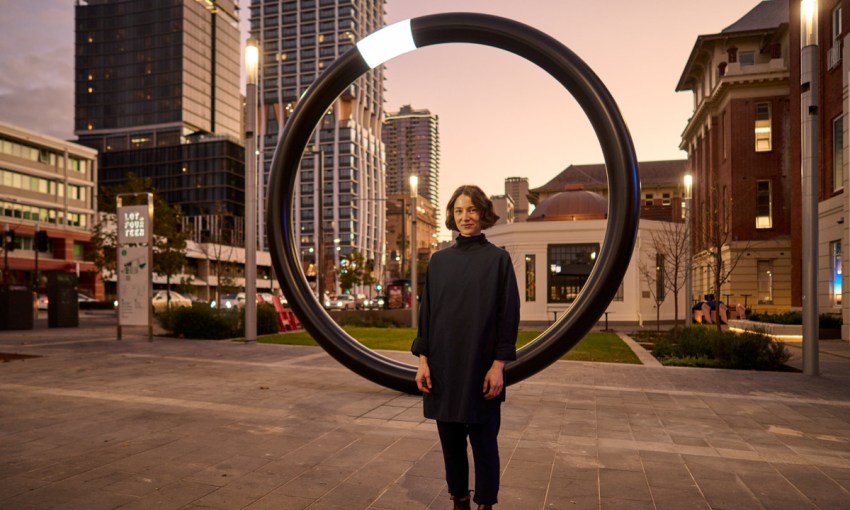A new sculpture by Sundari Carmody was unveiled at Lot Fourteen this week, through which the early-career artist explores the ways humanity's search for knowledge sometimes leads to a deeper sense of unknowing.
Into the unknown with Sundari Carmody
Sundari Carmody has always been fascinated by things unseen.
Growing up in Bali, amid the volcanic Ring of Fire, the artist would look out at the active volcano Gunung Agung – a massive geographical mass in the north-eastern skyline – and wonder about the life it lived beneath the earth’s surface.
“There’s a lot of acknowledgment of unseen energy in that culture, and [how] things that we can’t see have an effect on the things that we can see,” Sundari says.
“Gunung Agung… had a really big explosion in the ‘60s. It erupted and did a lot of damage, and a lot of people went there to pray while it was erupting, trying to appease the gods.
“The volcano is a form that is a good example of hinting at things that we can’t see or sense or know.”
The influence the looming Gunung Agung had on Sundari was evident in her first sculptural work, ‘The Build Up’, exhibited at CACSA Project Space in 2014. It was a 1.6-metre-tall velveteen likeness of a volcano.
Prior to ‘The Build Up’, Sundari predominantly made art in two-dimensions, as a photographer. Even then, she would put effort into highlighting each photograph as a physical object as much as a piece of visual communication.
“I was often trying to push the photographic object to become an object, by making sure that I wasn’t cleaning up the dust marks and all of that too much – because I was shooting with film,” she says. Her aim was to create “a more tactile, sensory experience” for the viewer.
To create ‘The Build Up’, Sundari learned to sew, and she was encouraged by her partner, artist Matthew Bradley, to consider the practicalities of building a three-dimensional object for a gallery. (“It’s not going to float in mid-air. How’s that going to work?”) Executing the sculptural work proved to the artist she was able to communicate her ideas through more ambitious methods.
There has been no work in Sundari’s career as ambitious as the one revealed this week in the forecourt of Lot Fourteen, out front of the Australian Space Discovery Centre.
New here? Sign up to receive the latest happenings from around our city, sent every Thursday afternoon.
Titled ‘One: all that we can see’, the work is a large, black tubular ring, made from steel and measuring four metres in diameter. There is a glowing section at the top of the ring, lit by LEDs.
‘One’ is the result of another of Sundari’s fascinations with the unseen, this time in the realm of astronomy. The lighted section represents the five per cent of the universe humans are able to see; the pitch-black steel is the 95 per cent that is invisible to us – what is known as dark matter and dark energy.

All we know is not a lot
Sundari first exhibited a version of ‘One’ in 2017, as part of her show Steady Illiterate Movement at Seventh Gallery in Melbourne. It was then much smaller in scale – 40cm x 40cm – and was essentially a 2D work, hung on a wall.
Even in this grander form, the artist describes ‘One’, humbly, as a pie chart. But it is the result of an intense period of studying the work of pioneering astronomers, such as Vera Rubin and Kent Ford.
In the 1970s, the astronomers studied the Andromeda Galaxy by looking at photographic plates, measuring the velocity of its stars. Andromeda is a spiral galaxy, like our home, the Milky Way, and the hypothesis they started with was stars in the centre of the galaxy should move faster than those on the outer edges, due to the effects of gravity and dissipating mass. “What they actually saw was the opposite,” Sundari says. “That they were moving so fast, just as fast as in the centre, that they should have been flinging off into space.” There must be, the scientists deduced, unseeable matter affecting the movement of the stars.
It’s an example of the accumulation of knowledge only leading to a deeper sense of mystery.
“I was just so drawn by that idea,” Sundari says. “Seeing something, but knowing that there’s so much more beyond what you can see because of the effect it’s having on the things you can see.
“That’s just so fascinating, to look at that and realise we’re just these tiny things and part of this huge system – which we can’t see.”
The earlier iteration of ‘One: all that we can see”
View this post on Instagram
Sundari was selected for the Lot Fourteen commission after being asked to apply by Guildhouse, who advised on the project alongside the Australian Space Discovery Centre and Lot Fourteen’s Arts and Culture Advisory Group. After being awarded the opportunity, Guildhouse put Sundari in contact with Exhibition Studios, which constructed the work.
‘One’ has obvious thematic links to the Space Discover Centre, but still Sundari seems unable to comprehend having been selected to contribute to such a prominent South Australian site.
“I just thought that that’s way beyond what I could do. I mean, maybe way down the track, but I didn’t think it’d be this soon,” she says.
“There’s a lot of red tape, there’s a lot of bureaucracy, there’s a lot of engineering reports. Is someone going to climb it? Is someone going to tear it down? All of that sort of stuff.
“It’s been such a great experience working with Guildhouse and Exhibition Studios, because I feel like they really protected me from all of the email back and forth.”
When we ask Sundari about the meaning of having an artwork of this size in the public realm at this point in her career (she was part of Adelaide Contemporary Experimental’s Studio Program for early-career artists last year), she speaks dreamily of the way Bert Flugelman’s ‘Spheres’ melded into Adelaide’s self-identity to become known colloquially as the Mall’s Balls.
“If this can become part of the community, like the Malls Balls, then that’s amazing,” she laughs. “There’s already been really funny comments from people, which I’m very open to.”

But Sundari isn’t getting too far ahead of herself. She’s seen other South Australian artists go “down this very same path”, only to then, once again, become unseen. “It can fizzle out,” she says.
On the day we speak, the protective wrapping is partially removed from ‘One’. Even now, she’s barely accepting the commission as a deserved success.
“Do you remember in the Olympics, Bradbury, who won the ice skating? It’s kind of how it feels,” Sundari laughs.
“But he worked very hard to get to the Olympics. He trained and he spent hours and hours and hours – but no one expected him to do it.
“So, it’s humbling, but it’s also, well, there’s a lot of work that went into that, too. But it’s a surprise still,” she laughs again. “It’s like a Bradbury moment.”
Crippling humility aside, Sundari hopes “more and more artists can experience what I experienced”.
“There are so many great artists in this city, who make such interesting work, and I think they would benefit from having that support,” she says.
“But I think also the city would benefit from seeing contemporary artists making work, not just seeing works from the ‘70s – which are great works, but I think we need to still keep supporting the artists of today.”
Find ‘One: all that we can see’ at Lot Fourteen, out front of the Australian Space Discovery Centre, on North Terrace.
Connect with Sundari on Instagram.




